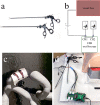Phantom study on surgical performance in augmented reality laparoscopy
- PMID: 36547767
- PMCID: PMC10363058
- DOI: 10.1007/s11548-022-02809-7
Phantom study on surgical performance in augmented reality laparoscopy
Abstract
Purpose: Only a few studies have evaluated Augmented Reality (AR) in in vivo simulations compared to traditional laparoscopy; further research is especially needed regarding the most effective AR visualization technique. This pilot study aims to determine, under controlled conditions on a 3D-printed phantom, whether an AR laparoscope improves surgical outcomes over conventional laparoscopy without augmentation.
Methods: We selected six surgical residents at a similar level of training and had them perform a laparoscopic task. The participants repeated the experiment three times, using different 3D phantoms and visualizations: Floating AR, Occlusion AR, and without any AR visualization (Control). Surgical performance was determined using objective measurements. Subjective measures, such as task load and potential application areas, were collected with questionnaires.
Results: Differences in operative time, total touching time, and SurgTLX scores showed no statistical significance ([Formula: see text]). However, when assessing the invasiveness of the simulated intervention, the comparison revealed a statistically significant difference ([Formula: see text]). Participants felt AR could be useful for various surgeries, especially for liver, sigmoid, and pancreatic resections (100%). Almost all participants agreed that AR could potentially lead to improved surgical parameters, such as operative time (83%), complication rate (83%), and identifying risk structures (83%).
Conclusion: According to our results, AR may have great potential in visceral surgery and based on the objective measures of the study, may improve surgeons' performance in terms of an atraumatic approach. In this pilot study, participants consistently took more time to complete the task, had more contact with the vascular tree, were significantly more invasive, and scored higher on the SurgTLX survey than with AR.
Keywords: Augmented reality; Instrument tracking; Intraoperative navigation; Laparoscopy; Phantom study; Visualization.
© 2022. The Author(s).
Conflict of interest statement
The authors report that there are no competing interests to declare.
Figures







References
-
- Syn NL, Kabir T, Koh YX, Tan HL, Wang LZ, Chin BZ, Wee I, Teo JY, Tai BC, Goh BKP. Survival advantage of laparoscopic versus open resection for colorectal liver metastases: a meta-analysis of individual patient data from randomized trials and propensity-score matched studies. Ann Surg. 2020;272(2):253–265. doi: 10.1097/SLA.0000000000003672. - DOI - PubMed
-
- Tendick F, Jennings RW, Tharp G, Sensing SL. Manipulation problems in endoscopic surgery: experiment, analysis, and observation. Presence Teleoper Virtual Environ. 1993;2(1):66–81. doi: 10.1162/pres.1993.2.1.66. - DOI
MeSH terms
Grants and funding
LinkOut - more resources
Full Text Sources
Other Literature Sources
Research Materials

